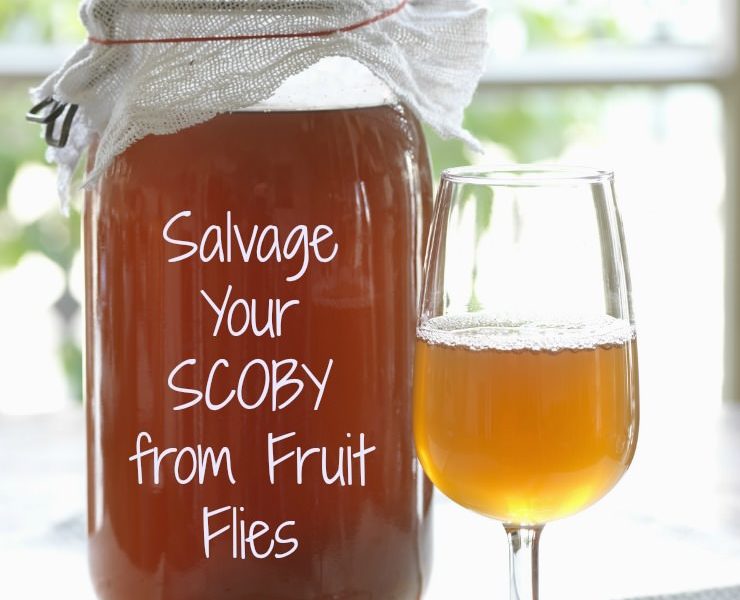
The fruit flies are really a challenge in my neck of the woods this year. They seem much more prevalent than in any years past that I remember. Fruit flies love, and I mean looove, kombucha and its cousin made with honey, Jun tea, also called kombucha champagne.
There’s something about the sweet and slightly sour smell and flavor that drives them absolutely nuts. Fruit flies also love to hang out or lay their eggs on the starter culture for these homebrews, popularly known by the acronym SCOBY (symbiotic culture of bacteria and yeast).
If you brew either of these healthful and hydrating traditional beverages, you have no doubt noticed this too.
Half filled glasses of kombucha or Jun tea left anywhere in the house have the potential to cause the fruit flies to swarm as will leaving your homebrews uncovered even for a few minutes on the kitchen counter.
What do you do if you’ve only just discovered this and already have fruit flies doing laps in your fermentation vessel, or worse (ugh), fruit fly larvae that have taken up residence on your Jun tea or kombucha SCOBY?
The good news is that you don’t necessarily have to get a new culture. The bad news is that you are going to have to get over any deep-seated feelings of ewwww that arise during the recovery process and realize that everything is going to be ok and a few fruit flies and/or larva are not going to hurt you.
So take a deep breath. Inhale. Exhale.
Ready to move on? Ok, here we go.
Recovering a SCOBY from Fruit Flies
The excellent instructions below on how to recover a Jun tea or kombucha SCOBY from a fruit fly invasion come from my friend Hannah of Kombucha Kamp.
I highly recommend the Kombucha Kamp website that Hannah runs with her husband Alex for any and all your kombucha and Jun tea supplies. Hannah and Alex only sell the good stuff – never cultures that are dehydrated, refrigerated or cut down to a small size for mailing convenience. This type of culture has been weakened and can produce mold. Kombucha Kamp cultures are full strength only.
The first thing Hannah has to say about saving your kombucha SCOBY from the invaders is this: realize that the larvae and worms on the kombucha culture did NOT come from the brew. They came from the outside. This knowledge will hopefully help you prevent this problem from occurring again in the future.
If the worms are resting on top, and there are just a few of them, it might be a salvageable situation. Here are the steps to follow:
Mild SCOBY Infestation
A mild SCOBY infestation is defined as just a few eggs and/or larvae resting on top of the culture. To start the recovery process, carefully remove the infested SCOBY from your kombucha or Jun tea brew. Do this slowly so no eggs or larvae fall into the kombucha or Jun tea. Rinse off the culture in filtered water to remove all traces of the flies, eggs and/or larvae.
If needed, filter your kombucha or Jun tea brew to remove any fruit flies or eggs that may have fallen in. If the idea of doing this totally grosses you out, feel free to toss if desired. Start a new batch of kombucha or Jun tea.
Severe SCOBY Infestation
A severe fruit fly infestation is more than a few eggs, larvae or flies hanging out on your SCOBY. Let your internal definition of ewwww be your guide here.
In the case of a severe infestation, throw away the infested SCOBY in the garbage or better yet, use it for compost. Pour out the kombucha or Jun tea, ideally in the garden as the probiotics will really get the worms going and improve the soil. Scrub the fermentation container in warm water and mild soap to remove any residue of the fruit fly eggs/larvae. It is best to avoid the use of the dishwasher and never use toxic dishwasher powder for any glass container that will hold a ferment! Restart the brewing process with a fresh starter and a new culture.
How to Prevent a Fruit Fly Infestation
Prevention is always the best policy when it comes to fruit flies. Here are some tips that Hannah suggests so you never have to deal with fruit flies, eggs, larvae, or worms on your kombucha or Jun tea SCOBY in the first place:
Secure the cloth that covers your fermentation vessel with a rubber band (not tape) or use a brewer cap. Clear the area of any flies that are nearby whenever you remove the cloth from the top of your fermentation vessel. It is a good policy to never leave your fermentation vessel uncovered, even for just a moment.
Take a good look at the fermentation cover you are using and make sure it has a small enough weave to prevent fruit flies from wriggling through. Note in the picture above that the cheesecloth cover is likely too porous to prevent fruit flies from getting through.
Set up fruit fly traps to minimize the amount of flies present. This video below from Kombucha Kamp will show you how to use a small container of kombucha or Jun tea to function as a trap for fruit flies to prevent an infestation of your fermentation vessels themselves:
Happy fruit fly-less brewing 🙂
More Information on Kombucha and Jun Tea
Fluoride in Kombucha: Should You Be Concerned?
Can Candida Sufferers Drink Kombucha?
Does Kombucha Prevent Grey Hair?
Batch vs Continuous Brew Kombucha
Safe Traveling with Kombucha
Kombucha: Drink It and Wear It?
Maple Kombucha Salad Dressing








I found out that into the kombucha container were fruits flies, I don’t know if they layed eggs in my scobys the kombucha taste good, I put back to the scobys into clean container with new tea , how can I know if the are infected please let me know thank you